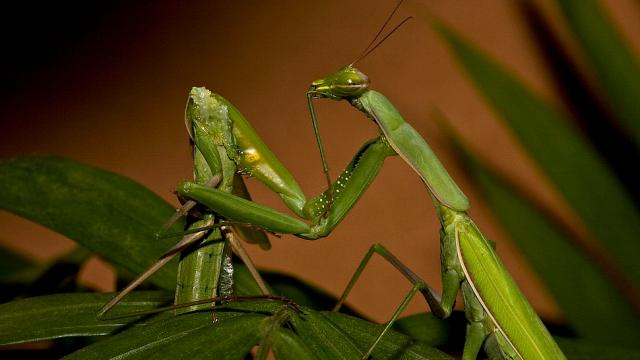Female praying mantises have a habit of killing and eating their partners during sex, which sucks for the male. Or does it? A fascinating new study shows that this sacrifice is actually giving the males a distinct reproductive advantage.
A female praying mantis with what’s left of her partner. (Image: Oliver Koemmerling)
Sexual cannibalism among praying mantises is well documented, but scientists have debated the reasons for it. A new study published in Proceedings of the Royal Society B shows that females who eat their male partners after sex produce more eggs than those who don’t. What’s more, by eating the male, the widowed female ensures that her man is still providing for their offspring, even though he’s dead.
William Brown, a scientist at State University of New York at Fredonia and co-author of the new study, put it well: “Sexual cannibalism thus increases male investment in offspring.”
In praying mantises, around 25 per cent of all sexual encounters result in the death of the male. The female typically begins by biting off her partner’s head, and she works down from there. Incredibly, this comprises about 63 per cent of the female’s diet during the mating season. Scientists have speculated that it’s a way for the female to record a quick meal at a critical point in her reproductive life cycle, but this claim has largely remained unproven.
To see if this is actually the case, the researchers embedded traceable radioactive amino acids into crickets, which were subsequently fed to a population of male mantises. Each of these males was then paired with a female. Half of them were rescued from their two-faced lovers before cannibalism could take place, while the other half… well you know what happened to the other half. The researchers then set about the task of studying the reproductive success of each female involved.
By following the flow of radioactive proteins through the bodies of the females, the scientists could track the contribution of the recently-devoured male. Males who were devoured passed on nearly 90 per cent of their tagged amino acids, while those who survived passed on about 25 per cent — all of which were delivered via their ejaculate.
A significant portion of the amino acids were passed down to the baby mantises, which means they weren’t fully metabolised by the female. This means that, in addition to the male’s ejaculate, his body tissue is being used to produce eggs. The male — by virtue of his death — is providing nourishment to his offspring.
Those females who ate their partners produced more eggs than those who did not. On average, cannibalistic females produced about 88 eggs, whereas those who didn’t eat their partners produced about 37. That’s a big difference, one that gives cannibalised males a distinct reproductive advantage.
Well, at least in one-off situations. Males who survive mating encounters can potentially reproduce multiple times, which can also be seen as a reproductive advantage. Clearly, there’s an evolutionary tension here, one the scientists will have to look into a bit further.
Sexual cannibalism has also been observed in some spiders. But unlike these arachnids, whose reproductive organs become permanently damaged after sex, male mantises are able to copulate multiple times.
